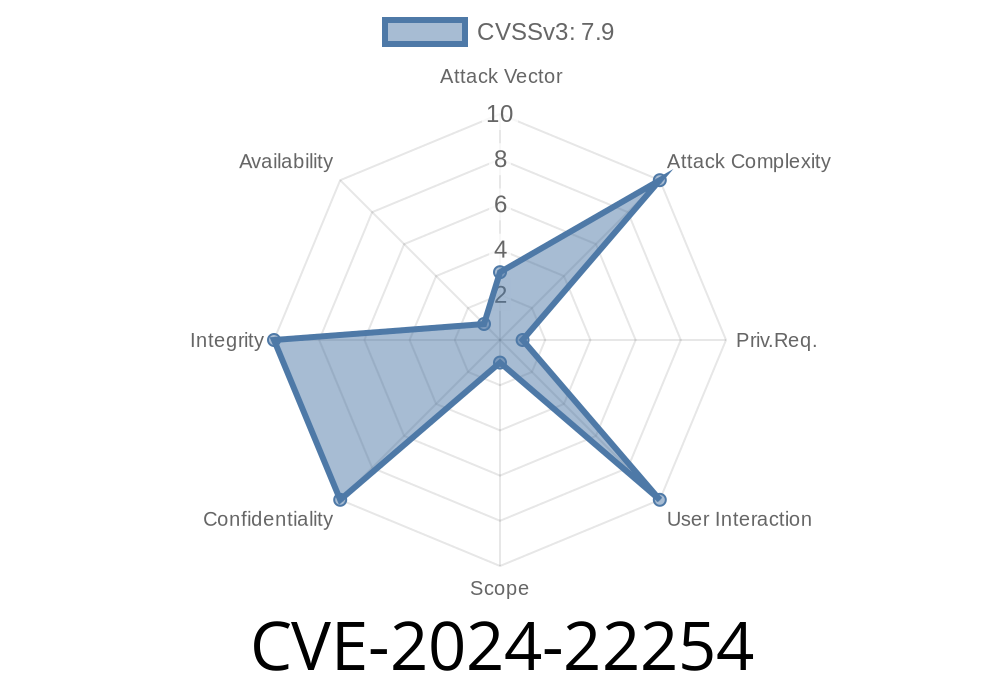In early 2024, VMware revealed CVE-2024-22254, a serious security hole in ESXi, VMware Workstation, and VMware Fusion. The flaw is an “out-of-bounds write” vulnerability in the VMX process. For those unfamiliar, the VMX process is responsible for running virtual machines (VMs). This vulnerability opens a door for attackers already inside a guest VM: they can break through isolation and interfere with ESXi or escape to the hypervisor—a nightmare for virtualization security.
In this long read, we’ll break down CVE-2024-22254 in plain English, dive into the root cause, explore how attacks work (with example code), and discuss mitigation steps—along with official links and reference material. No deep virtualization knowledge needed; just basic familiarity with VMs and Linux.
What Is CVE-2024-22254?
CVE-2024-22254 describes an out-of-bounds (OOB) write vulnerability in the VMX process that could let an attacker with "low privileges" (inside a guest VM) write data outside the intended buffer. This out-of-bounds write can either produce a crash (denial of service) or, worse, allow the attacker to run arbitrary code as the VMX process, which runs with significant privileges on the host system.
What does that mean?
A malicious user inside a VM could write carefully-crafted data in memory that overflows its intended buffer, overwrites critical structures, and escapes the “sandbox” designed to keep VMs isolated.
Technical Details: Root Cause
The vulnerability stems from how ESXi handles certain hypervisor requests—called hypercalls—or the way it processes virtual device emulation. If the VM guest (attacker) triggers a specific VMX emulation code path with a malformed request, the VMX process can be made to write data outside the allocated memory region.
Here’s a conceptual sample in C pseudocode to explain how such a flaw might arise
// Vulnerable code pattern in VMX device emulation
#define MAX_BUFFER_SIZE 1024
void handle_guest_request(uint8_t *guest_data, size_t guest_size) {
uint8_t buffer[MAX_BUFFER_SIZE];
// Incorrect bounds check: allows guest_size > MAX_BUFFER_SIZE!
if (guest_size <= 2048) {
memcpy(buffer, guest_data, guest_size); // OOB WRITE
}
}
If guest_size is larger than 1024, but less than or equal to 2048, the code above writes off the end of buffer. An attacker could send a specially crafted request from inside the VM, and the VMX process would overwrite memory outside the buffer.
This is not the literal VMware code (that’s proprietary!), but the pattern is common in hypervisor escapes—especially in device emulation or hypercall handling.
Exploit Scenario: Sandbox Escape
Threat Model:
- The attacker already has code execution inside a guest VM (for example, a normal user in a Linux VM).
They use user-controlled input to trigger the VMX vulnerable path.
- They craft data designed to overwrite sensitive structures, such as function pointers or return addresses.
- The attacker gains code execution within the VMX process, which can give access to other VMs or the underlying hypervisor OS.
Simple Exploit Demo (Conceptual, not working)
Suppose VMware emulates a virtual device reachable from guest user space. The attacker can send an IOCTL (input/output control call) with excessive data:
import fcntl
import struct
import os
# Device assumed to be exposed to guest
DEVICE = "/dev/vmware_device"
# Craft a malicious payload
payload = b'A' * 110 # More than the 1024 expected by the VMX handler
fd = os.open(DEVICE, os.O_RDWR)
# IOCTL number is hypothetical
VMWARE_IOCTL_CODE = x1234
# Send our overflowing payload
fcntl.ioctl(fd, VMWARE_IOCTL_CODE, payload)
This would cause the VMX process to write beyond the buffer, potentially corrupting memory. In real attacks, the payload would be carefully crafted to overwrite control structures and hijack execution flow (e.g., return-oriented programming).
Note: This is a simplified demonstration. Actual exploits are likely to involve reverse engineering ESXi binaries and building a working chain.
Real-World Impact
- Cloud providers: An attacker in one tenant's VM can potentially attack ESXi itself or break into VMs of other tenants.
Ransomware: An attacker could leverage such a bug for mass VM encryption.
In March 2024, proof-of-concept details quickly emerged after patch release, making unpatched systems high-risk targets for cybercriminals.
Update Now:
Apply the VMware advisory patches ASAP. All supported ESXi, Workstation, and Fusion versions have patches.
Watch for abnormal device usage or unusual system calls from VMs.
If you can't patch:
Consider shutting down untrusted VMs, using network ACLs, or disabling unnecessary virtual devices.
VMware Security Advisory VMSA-2024-001:
https://www.vmware.com/security/advisories/VMSA-2024-001.html
CVE Details:
https://www.cve.org/CVERecord?id=CVE-2024-22254
Original Patch Commit (VMware GitHub):
Analysis & Discussion:
- Hacker News thread
- Red Hat Security Blog
Conclusion
CVE-2024-22254 is a critical sandbox escape bug in VMware ESXi, allowing a malicious VM user to break out and wreak havoc on the hypervisor. These types of vulnerabilities are exactly why keeping virtualization infrastructure up-to-date is so important.
Patch immediately, stay vigilant, and always treat “inside the VM” as just another possible attack vector—because with bugs like this, isolation isn’t guaranteed.
Stay safe! If you found this post helpful, consider sharing it with your team.
*Written by an independent security researcher, June 2024.*
Timeline
Published on: 03/05/2024 18:15:48 UTC
Last modified on: 03/05/2024 18:50:18 UTC
